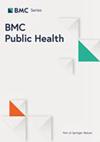Association between total body muscle-fat ratio and risk of thyroid disorders: a cross-sectional study
IF 3.5
2区 医学
Q1 PUBLIC, ENVIRONMENTAL & OCCUPATIONAL HEALTH
引用次数: 0
Abstract
Thyroid disorders(TD) poses a significant health threat to Americans due to its high incidence rate. Obesity, a common factor linked to thyroid disorders, has garnered increasing attention. While Body mass index (BMI) is a widely used obesity index, it fails to account for the distribution of muscle and fat in the body. Recently, tMFR has emerged as a crucial obesity index in clinical research, warranting further investigation into its association with TD. Exploring the association between tMFR and thyroid disorders. A comprehensive survey and data analysis were conducted using the NHANES database to investigate the relationship between tMFR and the risk of TD. This study utilized multiple logistic regression, smooth curve fitting, and subgroup analysis across four periods from 2011 to 2018. A total of 11,912 subjects were included in the study, showing a prevalence of 7.14% for TD. The research indicated that tMFR had an inverse correlation with the risk of TD in a comprehensive model (OR = 0.90, 95% CI 0.82 to 1.00). When tMFR was divided into quartiles (Q1-Q4), individuals in the highest quartile had a 28% lower risk of TD than those in Q1 (OR = 0.72, 95% CI 0.57 to 0.91). Analysis using smoothed curve fitting demonstrated a nonlinear relationship between tMFR and TD risk, with the inflection point for tMFR saturation effect identified as 1.5. Subgroup analysis further confirmed the strong association between tMFR and TD risk. Receiver operating characteristic (ROC) curve analysis indicated that tMFR exhibited superior predictive ability for TD relative to BMI. The study found a negative association between tMFR and the risk of TD; however, additional prospective studies are required to validate these findings.全身肌肉-脂肪比率与甲状腺疾病风险之间的关系:一项横断面研究
甲状腺疾病(TD)发病率高,对美国人的健康构成严重威胁。肥胖是与甲状腺疾病相关的一个常见因素,已引起越来越多的关注。虽然身体质量指数(BMI)是一种广泛使用的肥胖指数,但它没有考虑到肌肉和脂肪在体内的分布。最近,tMFR 已成为临床研究中一个重要的肥胖指数,值得进一步研究它与 TD 的关系。探索tMFR与甲状腺疾病的关系。本研究利用国家健康调查(NHANES)数据库进行了一项全面调查和数据分析,以探讨tMFR与TD风险之间的关系。这项研究采用了多元逻辑回归、平滑曲线拟合和亚组分析等方法,横跨2011年至2018年四个时期。研究共纳入 11912 名受试者,结果显示 TD 患病率为 7.14%。研究表明,在综合模型中,tMFR与TD风险呈反相关关系(OR = 0.90,95% CI 0.82至1.00)。当 tMFR 被分为四分位数(Q1-Q4)时,处于最高四分位数的人患 TD 的风险比处于第一四分位数的人低 28%(OR = 0.72,95% CI 0.57 至 0.91)。使用平滑曲线拟合进行的分析表明,tMFR 与 TD 风险之间存在非线性关系,tMFR 饱和效应的拐点确定为 1.5。亚组分析进一步证实了 tMFR 与 TD 风险之间的密切联系。接收者操作特征(ROC)曲线分析表明,相对于体重指数,tMFR 对 TD 的预测能力更强。研究发现,tMFR 与 TD 风险之间存在负相关;但是,还需要更多的前瞻性研究来验证这些发现。
本文章由计算机程序翻译,如有差异,请以英文原文为准。
求助全文
约1分钟内获得全文
求助全文
来源期刊

BMC Public Health
医学-公共卫生、环境卫生与职业卫生
CiteScore
6.50
自引率
4.40%
发文量
2108
审稿时长
1 months
期刊介绍:
BMC Public Health is an open access, peer-reviewed journal that considers articles on the epidemiology of disease and the understanding of all aspects of public health. The journal has a special focus on the social determinants of health, the environmental, behavioral, and occupational correlates of health and disease, and the impact of health policies, practices and interventions on the community.
 求助内容:
求助内容: 应助结果提醒方式:
应助结果提醒方式:


